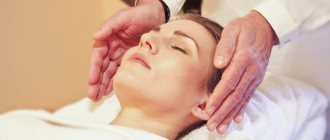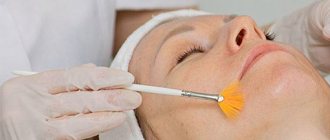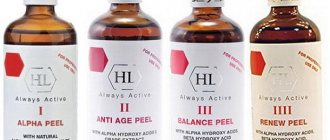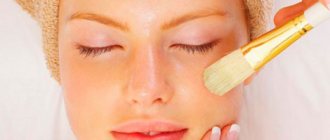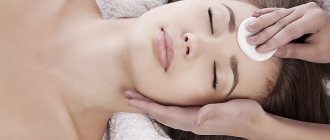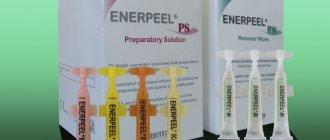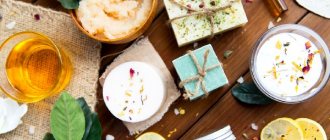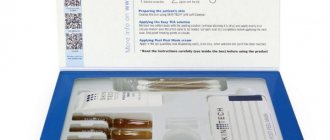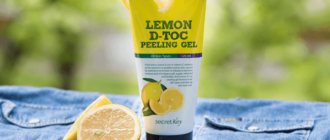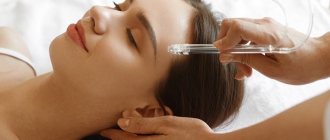Yellow (retinoic) peeling has won the sincere love of visitors to beauty salons. It helps to actively fight acne and wrinkles. In salons, a course of procedures will be expensive: at least 15,000 rubles. For reasons of economy, a reasonable question arises: is it possible to carry out yellow peeling at home? Let's figure it out.
Yellow peeling – what is it?
Among ordinary people, this procedure is better known as yellow peeling rather than retinoic peeling, due to the color of the film that forms on the face during the process. Another unofficial name for the manipulation is “weekend exfoliation,” since after the service is provided, the skin heals very quickly, literally in a couple of days. Therefore, many women make an appointment with a cosmetologist on Friday in order to come to work after the weekend with a fresh and well-groomed face without any consequences of cleansing.
Experts divide cleaning according to the degree of penetration into the skin into superficial, middle and deep, and according to the degree of impact on the dermis - into mechanical and chemical. If we talk about yellow peeling, it has a chemical effect at the surface or middle level.
Recommended articles on the topic:
- Ultrasonic facial peeling is a pleasant and beneficial procedure for your skin
- Redermalization of the skin: all the pros and cons
- Almond peeling for the face: features of the procedure
The mask contains retinol, or retinoic acid. This drug has beneficial properties that have a positive effect on the condition of the skin. It triggers intracellular processes, while gently influencing the dermis of the face.
Let's say a few words about the properties of retinoic acid.
It is close in structure and properties to vinegar. However, when in contact with facial skin, retinoic acid has a milder effect and helps exfoliate dead cells.
Types of retinoic peeling
In the modern world, retinoic peeling is divided into:
- One-day. All manipulations are carried out in one day. The peeling mask must be removed from the face after 12 hours.
- Two days. In this case, the face is treated for two days in a row. The specialist applies the product several times, and before each application he rinses off the mixture. The last peeling remains on the face and is not washed off. You need to remove it yourself at home after 2 hours. But the next day you should go for a repeat procedure.
It’s not always possible to devote 2 days to visiting a salon. In this case, it is recommended to lean towards the first option. But you need to remember that as a result you will have to walk around with a yellow face for a long time.
These peels contain 5-10% retinoic acid.
Plastic surgeon Christopher Davidson
Properties of yellow peeling
Beneficial features:
- Stimulation and rejuvenation of the skin.
Retinoic yellow peeling helps improve metabolism in the dermis, stabilizes cell membranes, accelerates their regeneration, protects against harmful radicals, and forms new protein structures such as collagen and elastin.
- Improving the protective properties of the skin.
Such cleaning helps to improve and restore the natural immunity of the dermis, with the help of which it can protect itself from pathogenic microbes. Also, strong immunity promotes rapid healing of wounds.
- Restoration of epithelial tissues in a number of skin diseases.
Retinoic acid helps get rid of acne, acne, loss of pigment at wound sites, and rapid skin regeneration after burns. It helps with psoriasis and dermatitis.
- Lightening facial skin.
Retinoic yellow peeling produces a brightening effect on the skin. The components it contains block the activity of the enzyme tyrosinase, which promotes the release of melanin. Due to the increased activity of the latter, freckles, post-acne and hyperpigmentation appear on the face.
- Prevention of cancer.
There is an opinion among experts that retinoic acid, through its action, can destroy damaged and weak skin cells, preventing the formation of harmful tumors in them, which could lead to the formation of a benign or malignant tumor.
How does yellow facial peel work?
Cosmetic manipulation renews the skin and improves the condition of your skin. However, its effect is completely different from other types of exfoliation, which tend to act on the skin from the outside, while the yellow peel solves problems by dealing with them from the inside. Let's take a closer look at this process.
To better understand the differences, let’s compare the effects of retinoic and fruit acids, namely glycolic acid. The latter grossly disrupts the outer layer of the skin, damaging it and removing dead cells, which are subsequently replaced with new ones. Retinoic acid has a milder effect on the dermis of the face, working not with cells directly, but with intercellular structures.
Retinoids do not interact with the top layer of the skin, but with the basal layer, where cells are born. Due to their structure, microparticles of the medicinal substance quickly penetrate to their destination and promote accelerated division and formation of new cells. They begin to actively move towards the surface of the skin and take the place of dead specimens, pushing them out. As a result, the dermis is exfoliated and renewed.
Thus, this composition does not act aggressively on the skin of the face, destroying old cells. On the contrary, it works from the inside and helps the emergence of new healthy specimens. Retinoic acid also helps improve the density and elasticity of your facial skin and its uniform pigmentation.
In addition to this substance, the medicinal composition also contains other components that have a positive effect on the condition of the dermis, such as:
- Phytic, kojic, azeloic acids, which help whiten the skin.
- Salicylic acid – exfoliates dead cells.
- Vitamin C fights free radicals.
- Allantoin, aloe and chamomile extracts produce a calming effect.
Here are some benefits of a cosmetic service:
- has a gentle effect on the skin, there is virtually no discomfort or burning during the procedure;
- after the first session you will be able to see a significant improvement in the condition of your dermis;
- no side effects, skin healing occurs one to two days after the procedure;
- four to five sessions will be enough to consolidate the result;
- the effect lasts for three to four months.
general description
Phenol peeling is an exfoliation of the skin.
It is carried out using carbolic acid. Traditional components of phenol peeling compositions are:
- distilled water;
- glycerol;
- oil that accelerates the absorption of carbolic acid into the epidermis;
- phenol;
- propylene glycol.
One of the main features of phenol peeling is its high level of toxicity. This method is considered a dermatosurgical procedure, which must be performed by a specialist of a high level of competence. Deep phenol peeling can only be performed after a detailed medical examination of the cardiovascular system, liver and kidneys.
Deep peeling affects all layers of the dermis. The long recovery period after the procedure, up to 1 year in some patients, and the high probability of severe complications require extreme attention.
If you intend to undergo a phenol peel procedure solely for cosmetic purposes, it is recommended to resort to it only if there is no alternative solution to your problem.
Types of yellow peeling
Yellow peeling comes in two types. Cleanings differ in the amount of retinoic acid used and the time of the procedure.
Cosmetic brands offer exfoliating formulations with varying concentrations of retinoic acid. Thus, the professional product contains approximately 5–10% of this substance, as well as other auxiliary components: kojic, azeloic, phytic and other acids, which produce an additional effect, help whiten the skin, and soothe it.
The first composition contains synthetic retinoic acid, which is a high concentration of retinol. With this active substance content, the product has a deeper effect on the skin of the face. The medicinal composition is applied to the dermis twice with a break of one day. After completing the procedure, it is advisable to avoid direct sunlight, so it is recommended to do it in autumn or winter in mostly cloudy weather. Before the session, you need to prepare your facial skin.
The second composition contains natural retinoic acid, which has a more gentle effect on facial skin. Yellow cream peeling on a natural basis produces superficial cleansing of the dermis. The procedure is performed once every month, interrupted during the summer.
Preparatory stage
Before carrying out retinoic peeling, it is necessary to perform preparatory actions. One month before the procedure, you should stop tanning. Natural insolation and visiting a solarium are prohibited.
Approximately the same amount of time will be required to protect the skin from exposure to ultraviolet radiation after the intervention. Therefore, exposure is not recommended in the summer.
2 weeks before the procedure, any aggressive effects on the epidermis are excluded: cleansing masks, scrubs, hardware treatments. During this period, it is recommended to “introduce” the skin to the main active ingredient of retinoic peeling.
Carotenoids are found in many anti-aging products. You can make masks containing vitamin A twice a week. This will soften the epidermis and subsequently avoid negative reactions to peeling.
Before the session, it is important to do an allergy test of the composition: apply the product that is going to be used on the bend of the elbow. If negative reactions occur, the procedure is not performed on the face.
Yellow peeling with salicylic acid
If you want to achieve greater results and have a few days to complete a full facial skin treatment, the yellow peeling procedure with salicylic acid is suitable for you. Before applying yellow peeling, the cosmetologist treats the dermis with salicylic acid and then applies the main composition. This manipulation promotes active peeling of dead skin cells.
Salicylic acid actively helps remove dead skin cells from the surface of the face, resulting in a more effective effect of the main composition on problem areas. If your dermis is acne-prone, you should regularly cleanse with this substance. Therapeutic components help heal inflammation and get rid of acne, improve blood circulation and cell restoration process.
We recommend
Laser aesthetic cosmetology: perfect technique for perfect appearance More details
During the procedure, you may feel a slight burning sensation due to the active effect of salicylic and retinoic acids on problem areas of your skin.
After the first session you will notice an improvement in the condition of the dermis. However, do not forget that in order to consolidate the effect, you must undergo a course of treatment. As a result of proper therapy, you will become the owner of smooth, renewed skin. This manipulation will help you:
- Smooth out superficial wrinkles and reduce deep ones.
- Lighten or completely get rid of age spots.
- Even out skin texture and tone.
- Firm and tighten the dermis of the face.
After completing the procedure and removing the composition, you may notice redness of the skin, which is a natural reaction of the body. It will soon pass. However, a couple of days after your yellow salicylic acid peel session, a process will begin in which the top layer of your face's dermis will begin to crack and peel off.
Don’t be alarmed – this is how dead skin cells are removed from the surface so that their place can be taken by renewed and healthy cells. Of course, your appearance may raise many questions and not the most pleasant attention from colleagues and acquaintances. The use of concealing cosmetics will not help you much, and their use is not recommended, as it can limit the access of oxygen to new skin cells. Therefore, it is better to do yellow peeling at a time when you have a few free days to spend in peace at home.
As you know, salicylic acid dries the skin, so this manipulation is not recommended for people with dry skin. If you have thin and sensitive skin, the procedure may be harmful. Yellow peeling with acid is indicated for those with oily and combination skin types.
To consolidate the result, a course of three procedures should be carried out every two weeks. Next, you need to perform prophylaxis every three months.
Who is suitable for yellow skin peeling?
Retinoic yellow peeling is an almost universal cosmetic procedure that allows you to cope with many skin imperfections.
In addition to the usual set that any other exfoliation has, namely getting rid of dullness, greasiness and uneven surface of the dermis, yellow peeling will help you in the fight against:
- wrinkles;
- age spots;
- photoaging;
- decreased turgor;
- thickening of the stratum corneum.
As a rule, most often this cosmetic procedure is performed by women after 40 years of age with the appearance of age-related changes on the face. If you have acne or acne marks, you are also recommended to use this service.
Thanks to its medicinal composition, yellow peeling improves skin condition and helps:
- deeply cleanse the dermis, while producing an antibacterial effect that prevents the development of acne;
- stimulate the production of collagen and elastin, tighten facial contours and smooth out wrinkles;
- even out skin color, making it healthy and matte;
- lighten freckles, age spots and post-acne.
This cosmetic service is recommended for you if you:
- withered dermis, there are wrinkles;
- the sebaceous glands are too active;
- dry skin type;
- there are defects on the face (pits, scars, etc.);
- there are pimples, comedones, blackheads;
- unhealthy complexion.
As you can see, yellow peeling helps fight many skin diseases, so it can be performed by anyone who in one way or another wants to improve the condition of their skin.
Indications and contraindications
Indications for the retinoic peeling procedure:
- problems with collagen production;
- insufficient skin moisture;
- wrinkles caused by active facial expressions;
- low elasticity and firmness of the skin;
- the need to whiten the skin;
- pigment spots caused by sun exposure;
- acne;
- excessive skin pigmentation;
- hyperkeratosis.
Important ! In addition, manipulation is prescribed to cleanse the skin of various types of impurities, relieve inflammation, give a beautiful and uniform blush, even out the relief and structure of the skin, and tighten the oval of the face.
There are many things that can be corrected with this procedure.
Contraindications:
- if the client is allergic, it is possible that the skin will react negatively to the drug during the procedure. Retinoic acid also increases skin reactivity. Therefore, it is necessary to report even minor allergies to the cosmetologist;
- atopic skin reactions, seborrheic dermatitis, etc.;
- viral infections - they can cause the development of herpetic eruptions (if the person has already had this disease);
- warts – the procedure may cause this problem to spread throughout the body;
- photosensitivity - that is, increased susceptibility of the skin to sunlight or various types of radiation that have an ultraviolet component;
- taking certain medications - if the client took, for example, Roaccutane, he needs to refrain from this peeling for at least six months;
- liver disease, including a history of hepatitis;
- carrying a baby or planning a child in the coming year. Peeling is also prohibited during breastfeeding, since retinoids are dangerous for the embryo.
Contraindications must be taken into account
Contraindications to the yellow peeling procedure
Before carrying out the procedure, you must consult a cosmetologist. This manipulation has a number of contraindications, so you should find out in advance whether this service is right for you or whether it is not worth doing.
Yellow facial peeling is not recommended if you have:
- Allergy. By its effect on the skin of the face, retinol triggers an accelerated metabolism and makes the dermis more sensitive. If you have previously had allergic reactions, then after exfoliation there is a high probability of a relapse of the disease.
- Viruses and infections. For the reasons described above, the risk of developing pathologies caused by the activity of harmful microorganisms also increases. Most often, herpes may develop after the procedure.
- Photosensitivity. If your skin is sensitive to ultraviolet rays, it may burn after exfoliation.
- Liver diseases. The active components of the medicinal composition not only interact with skin cells, but also partially enter the blood and then the liver. If you have pathologies of this organ, retinoic acid can cause negative consequences.
- Skin diseases. If your dermis is damaged or can suffer from the slightest impact, you are not recommended to undergo the procedure, as it can cause burns and additional injuries.
- Pregnancy and lactation. The active component of yellow peeling - retinol - can negatively affect the health of the baby in the womb, so you should refrain from using the service a year before the expected pregnancy, while pregnant, and also during lactation.
- Taking certain medications. For example, if you take Roaccutane or other medications that are similar in composition and purpose, this service is not indicated for you during the course.
- Neoplasms. If you have a tumor on your face, it is not recommended to do yellow peeling, as exposure to it may cause it to grow.
Remember that you can do yellow peeling only if you have no contraindications. Even if you plan to perform this procedure at home, be sure to consult a specialist first.
Salon retinoic peeling “Arcadia” (Russia)
"Arcadia" is a line of domestically produced professional cosmetics for both superficial and deep cleansing and skin renewal.
The St. Petersburg laboratory of the same name is developing products for cosmetology clinics and salons.
Dry skin cleansing with professional Arcadia cosmetics is more like a long-term mask, but with glycolic acid and beta-carotene in the composition, which promote skin renewal.
The products themselves are quite liquid; they are applied evenly to the face and neck and left for 20 minutes to several hours.
After using the Arcadia gluconic-amber peeling, the composition is removed as a hardened film with particles of the dead layer within half an hour.
After completing the procedure, soothing moisturizing creams from professional cosmetics lines with high SPF are applied to the face.
Additionally, the doctor prescribes a day and night care cream. It is not recommended to sunbathe for 2 weeks after the session.
After the procedure, choose skin care products containing vitamin A, hyaluronic acid or Dead Sea minerals - they perfectly renew dermal cells.
How is yellow peeling performed in the salon?
This cosmetic procedure will help you renew your skin, make it fresh and shiny, get rid of dead cells and acne areas. Let's take a closer look at how yellow peeling is done in the salon.
Stage 1. Preparation.
It is strongly recommended that the procedure be performed only by a specially trained technician. Of course, you can buy yellow peeling to do it yourself at home, but in this case the responsibility will lie entirely with you, since if the subtleties are not followed or the dosage is incorrect, there is a high risk of negative consequences.
Before visiting a cosmetologist, you need to prepare your skin in a certain way:
- Use skincare products daily with a percentage of retinoic acid of 0.025–0.1%.
- Temporarily refrain from sunbathing and tanning.
If you have a fair skin type, start this preparation two weeks before the procedure. For those with dark skin, it is recommended to increase the duration of this stage to four weeks. This is due to the fact that dark skin is more sensitive to the active components of the composition.
We recommend
How to get rid of unwanted hair quickly, painlessly and forever Read more
Before starting the session, the cosmetologist must conduct a test for an allergic reaction. If the skin has not shown a negative response, you can safely proceed to the main stage.
Stage 2. Carrying out the procedure.
Yellow peeling, application protocol:
- The specialist cleanses the skin of cosmetics, dust and all types of impurities.
- Then the dermis must be wiped with salicylic or glycolic acid to superficially remove dead cells from the surface of the face. After such cleansing, the main composition will be easier to penetrate into problem areas.
- The main preparation is applied to the face using a brush.
- The medicinal composition is kept on the skin for 15 minutes. During the first procedure, it is recommended to use a product with a reduced concentration of retinol to adapt the dermis and eliminate the risk of chemical burns. In this case, the composition can be left on the face for up to 12 hours.
- 15 minutes after application, the drug hardens and forms a yellow film. After the procedure is completed, it must be removed. If you need to let the compound sit for several hours, you will have to remove it at home yourself.
After exfoliation, you should apply a protectant to your skin to act as a barrier to harmful ultraviolet rays.
Useful tips for those planning to undergo a course of yellow chemical peeling
- Contact only those specialists who have the necessary qualifications to perform the yellow peeling procedure with retinol. The quality of the service provided and your health directly depend on this.
- Pay attention to the cleanliness of the office and the sterility of the equipment.
- Before the procedure, the cosmetologist must conduct a consultation, during which he can check the condition of your skin for any contraindications to the procedure, and give recommendations for preparation.
- Listen to all expert advice. Remember that the final result depends on the correct adherence to the stages of the procedure.
- For some time after the session, try to avoid direct sunlight and refrain from going to the solarium.
- It is recommended to do the procedure in autumn or winter, when the weather is mostly cloudy and the risk of exposure to ultraviolet radiation is reduced. During the rest of the year, exposure to the sun can lead to premature photoaging of the skin and the appearance of age spots.
- How long to do yellow peeling? To consolidate the result, it is necessary to undergo a course of treatment of three sessions every two to three weeks. However, if you have minor facial skin problems, one procedure may be sufficient.
- You should not perform exfoliation if you are planning an event or public presence in the near future. After the service is provided, an unexpected allergic reaction may occur or the skin recovery time may increase, which may negatively affect your appearance.
- Assess all negative complications that may arise after the procedure.
- After the end of the session, it is advisable to get home by your own transport or by taxi. Since the composition is kept on the face for six hours or more, you will have to return to your place with the applied drug.
- There is an opinion that the active component of yellow peeling, retinol, can be harmful to health. This possibility cannot be excluded, however, for this to happen, the concentration of the substance must be enormous, which is impossible with this procedure, since a negligible amount of retinol enters the blood through the skin, which is then excreted from the body in the shortest possible time.
- Sometimes on the Internet you can find negative reviews about yellow peeling, the effect of which turned out to be insignificant. This is only possible with thick skin, since in this case the active components of the substance cannot penetrate through the dense structure to problem areas. To get the result, you must first do regular exfoliation, which will help remove the stratum corneum of the dermis and facilitate the penetration of the active substance.
It is worth remembering that yellow peeling, due to its effect on the skin, can lower your immunity and increase the risk of skin infection with various infections. As a result, herpes may appear. To avoid such consequences, the cosmetologist prescribes a course of medications before the procedure that are aimed at strengthening your immunity.
After the session, the following reactions may occur in some areas of the skin:
- redness;
- burning;
- increased sensitivity;
- slight swelling.
As a rule, all these phenomena disappear within a day or two after the procedure.
You can do yellow facial peeling only if you have serious skin problems and only in a salon with a professional cosmetologist in order to avoid negative consequences after the manipulation.
It is no secret that the skin, and especially the skin of exposed surfaces (face, neck, décolleté, hands) plays a significant role in shaping the aesthetic appeal of a person’s image. Unfortunately, like other organs, the skin undergoes age-related changes, which can create certain problems and complexes in people; Moreover, the share of the subjective factor in this issue seems to be very high. Involutional changes in the skin are caused by a decrease in the mitotic activity of epidermal and dermal cells, thinning of the Malpighian layer, hyperkeratosis, smoothing of the dermoepidermal border, a decrease in the number of full-fledged type I collagen fibers, elastic fibers, and glycosaminoglycans. Skin aging is characterized by changes in its density, elasticity, ptosis and the formation of wrinkles; in this case, the skin has a covering function, but does not support the rest of the facial tissues. This circumstance seems important from the standpoint of the correct choice of methods for correcting age-related changes in the face, since in addition to the skin, the involution process involves fatty, muscle and bone tissue, and therefore not all costs of age can be corrected by influencing only the skin.
Often, professional and/or personal motives to smooth out the influence of time lead a person to specialists in the field of plastic surgery and aesthetic cosmetology. Currently, to solve this problem, peeling has become widespread as an effective procedure that can eliminate a number of skin defects, as well as promote its “rejuvenation.”
Peeling
(from the English to peel, to peel off - peel off, exfoliate, exfoliate)
is the controlled removal of a certain number of layers of the epidermis and dermis along with existing defects to initiate the restoration of all destroyed layers. Thus, the physiological basis of peeling is stimulation of regeneration.
The doctrine of regeneration is one of the key branches of biology and medicine. Regeneration or revival is the property of organisms to re-form their organs and tissues that have been lost as a result of various reasons. Since the end of the 19th century. There is a division of regeneration into physiological and reparative, however, at present the border between these two types does not seem sharp. Reparative regeneration is based on physiological, the mechanisms for implementing the process are largely identical, and the differences are predominantly quantitative.
A cosmetologist, inflicting damage to the patient’s skin during salon peeling, stimulates reparative processes in it, the degree of manifestation of which depends on the nature and area of the injury. Thus, we can say that the basis of the corrective and “rejuvenating” effects of peeling is reparative (regenerative) morphogenesis.
The healing process can be considered as a complex sequence of interactions between cells, mediators, and components of the intercellular matrix, in the implementation of which a significant role (integration and operational communication) belongs to signaling protein molecules—cytokines.
Indications for peeling include seborrhea, acne and post-acne skin changes, scars, hyperpigmentation, actinic dermatitis, keratosis, hyperkeratosis, age-related skin changes (wrinkles, small folds, decreased turgor), etc. From the perspective of the doctrine of regeneration in elderly and senile people , which is characterized by thinning and atrophy of the skin, it does not seem advisable to prescribe peeling.
Based on the method of exposure, the following main types of peeling are distinguished:
- Mechanical
- superficial, medium (microdermabrasion) and deep (standard dermabrasion). This group includes gommage (peeling without abrasive particles by applying a special mixture to the skin, gluing it to the surface layer of the epidermis, followed by “rolling off” dead horny scales from the facial skin - similar to the action of a pencil eraser), peeling scrub (using abrasive particles) , brossage (hardware or brush peeling). - Chemical
- superficial (fruit acids), middle (salicylic and trichloroacetic acids), deep (phenol). - Physical
- superficial (ultrasound, erbium laser), medium (erbium laser with a penetration depth of 30 microns), deep (carbon dioxide laser with a penetration depth of 80-150 microns).
It should be noted that any type of deep peeling is an aggressive procedure for the skin.
The earliest mentions of manipulations similar to chemical peeling are found in ancient Egyptian papyri dating back to 1.5 thousand years BC. e. Since time immemorial, women have practiced exfoliating the top layers of skin to get rid of aesthetic imperfections on the face. Thus, Turkish women singed their skin with fire, Indian women used urine, Egyptian women used milk sourdough, ancient Roman courtesans, and later French women used grape must.
In the second half of the 19th century. German dermatologist Unna developed a dermatological chemical peeling method using resorcinol, salicylic and trichloroacetic acids for the treatment of certain skin diseases.
At the beginning of the 20th century. French surgeon La Gasse proposed phenol peeling, which was first used to correct gunpowder burns during the First World War. The surgeon's daughter took her father's secret recipes to California, where she introduced peeling into fashion in beauty salons in California and Florida.
In 1903, MasKee's work on the use of phenol solution for peeling was published, and in 1905, Kromayer unveiled a mechanical method for treating acne scars, keratosis and hyperpigmentation by treating the skin with rotating cutters, i.e., the dermabrasion method.
Van Scott's 1974 discovery of the properties of alpha-hydroxy acids and Kligman's research on the use of vitamin A as a treatment for photoinduced skin aging stimulated the widespread use of chemical peeling methods. Chemical peeling can be one-step and requires repetition, it can be carried out using various forms of cosmetics (cream, gel, solution, mask), and can also differ in the method of achieving the goal (peel exfoliant and peeling serum).
Peeling exfoliant
(using trichloroacetic, salicylic acids) promotes the development of a process traditionally called reparative regeneration. Moreover, depending on the depth of skin damage, a different range of structures is involved in its “rebirth”. Thus, when the surface layers of the epidermis are destroyed, restoration is carried out mainly due to the cambial elements of the skin epithelium located in its basal layer, i.e., on the basis of physiological regeneration of the epidermis, mainly by increasing its rate. At the same time, under the influence of cytokines synthesized by keratinocytes, the dermal elements are also activated, and the synthesis of collagen and glycosaminoglycans is enhanced.
With deep damage to the epidermis, and in some procedures to the dermis (phenol peeling), the main source of epithelial cells becomes the cambial elements of the skin appendages - hair follicles and glands, and processes similar to the healing of skin wounds develop in the dermis. The fibrosis of the dermis that forms during deep peeling as a result of the regenerative process, being essentially a pathological phenomenon, nevertheless contributes to the lifting effect desired and expected from the peeling. No other peeling gives such an effective and lasting result in the fight against deep expression wrinkles; Moreover, the achieved effect can last for 5-10 years after the procedure. Phenol peeling is called the “gold standard” of chemical peels. It is given to the patient once in a lifetime. Depending on how accurately the regenerative capabilities of the patient’s skin were assessed and how competently the procedure itself was carried out, phenol peeling either transforms the face, erasing wrinkles and other defects, or creates serious and long-term aesthetic problems for the patient.
The peeling serum causes loosening and exfoliation of the stratum corneum, but the main effect is achieved by weakening the barrier properties of the epidermis and facilitating the penetration into its deep layers of components that affect physiological regeneration. To do this, use a combination of alpha-hydroxy acids (glycolic, fruit, etc.), beta-hydroxy acids (salicylic acid, which has a keratolytic effect), retinol (vitamin A) and ascorbic acid (vitamin C), i.e. combined peeling ABR family (alpha-beta-retinol). The author of the monograph on the problem of peeling (2008) is N.A. Polonskaya believes that the further development of this branch of dermatocosmetology should not follow the path of increasingly severe and deep trauma to the skin, but in the direction of using the skin’s own resources and the body as a whole, using the most physiological methods of influence, if possible without depleting the reparative potential. In this regard, it is worth mentioning that many substances have the property of modulating, and in the light of the problem under discussion, stimulating the physiological regeneration of keratinocytes, and among retinoids, not only retinol, but also retinoic acids. For 13-cis-retinoic acid (INN - isotretinoin), this property has been proven experimentally using morphometric and quantitative immunomorphological studies using markers of DNA synthesis and proliferation - PCNA and Ki-67.
At the end of the 80s. XX century American dermatologist Obagi has developed a “Comprehensive Care Program”, which includes preparing the skin for a chemical peeling procedure and rehabilitation methods. According to his concept, the peeling procedure should include 3 fundamental phases:
- The preparatory stage (pre-peeling)
is aimed at leveling the epidermis and thinning its stratum corneum in order to more evenly penetrate acids and minimize the risk of post-inflammatory hyperpigmentation; at the same time, the reactive properties of the skin and its tolerance to the substances used in the peeling program are checked; - Peeling
; - Recovery period (post-peeling)
- involves a gentle regime (lack of physical activity, minimum facial expressions, avoidance of excess sweating, sleeping on your back, washing with non-hot water), using a moisturizer and sunscreen, spraying mineral water on the skin surface, applying a rich cream at night, when the skin is restored; Of the retinoids, retinol is most often used, applying it in the evening.
Patient management tactics are determined by the characteristics of the morphogenesis of skin structures at a specific stage of the process. Thus, in the acute phase of inflammation (immediately after the peeling procedure), the use of external agents that prevent transepidermal water loss is justified; later efforts should be aimed at eliminating erythema, swelling, preventing the contamination of the wound surface with pathogenic microflora and accelerating wound healing. These circumstances contribute to an intensive search for new means to obtain optimal results.
Contraindications to peeling are many skin diseases (eczema, psoriasis, allergic dermatoses), herpes infection, intolerance to photoprotective agents, pregnancy, the presence of multiple pigmented nevi on the face, hypertension, epilepsy, cancer, a special psychological type of the patient and others.
IN AND. Samartsev and T.R. Minaev note that most contraindications to peeling are relative. When deciding whether to prescribe phenol peeling, special caution should be exercised in relation to patients suffering from diseases of the cardiovascular system, kidneys and liver, since phenol has a toxic effect on these organs as a result of resorption. When performing phenol peeling, it is necessary to have a catheterized vein and the presence of equipment for cardiac monitoring and resuscitation in the operating room.
It should be emphasized that when deciding whether to prescribe peeling, special attention should be paid to the condition of the skin appendages (hair, sebaceous and sweat glands), since it is through them that the skin is largely restored after damage.
Ideas about the permissible depth of peeling vary in the literature. Numerous classifications allow for the possibility of skin damage during peeling, mainly within the epidermis, sometimes the papillary layer of the dermis, and in exceptional cases (with deep phenol peeling) - partially, the reticular layer of the dermis.
Below is a comparative description of the classifications of peelings, according to foreign and domestic publications, presented in the reports of the Scientific and Practical Conference “The Use of Chemical Peels in Dermatocosmetology”:
- superficial peeling
- performed with alpha-hydroxy acids (AHA), retinoids, alpha and beta complexes, while abroad up to the basement membrane, in Russia - within the stratum corneum; - median
- performed with trichloroacetic acid, Jessner's solution (a mixture of resorcinol, trichloroacetic and lactic acids), salicylic acid, abroad within the papillary layer of the dermis, in Russia - within the epidermis; - deep
- performed with phenol, abroad - to the reticular layer of the dermis, in Russia - to the papillary layer.
It should be borne in mind that when carrying out deep peeling, affecting the dermis, you have to sacrifice the epidermis. Cases where acid (all of the compounds presented above are acids) reaches the hypodermis are regarded as an emergency, since such a situation threatens the formation of rough scars.
ON THE. Polonskaya suggests classifying peelings based on the degree of skin damage:
- 1st degree
- within the stratum corneum; - 2nd degree
- within the epidermis without damage to the basal layer; - 3rd degree
- with partial damage to the basal layer; - 4th degree
- with complete destruction of the basal layer.
The degree of damage to skin structures during salon peeling determines the characteristics and duration of the recovery period.
Currently, there is a noticeable advancement of various aggressive techniques, which dictates the need for constant discussion of the feasibility of certain procedures, including on the pages of professional publications. When deciding on the use of a specific technique, it is necessary, first of all, to be guided by the principle “do no harm.” At the same time, both the patient and the cosmetologist are interested in obtaining a positive result. Particular skill lies in the ability to determine the degree of activity of the influence, which allows you to achieve the desired without significant side effects.
The most common currently are peels performed with AHA (mainly glycolic) and retinoic peels. Without touching on the details of the procedures used, we will name the main mechanisms of dermatotropic effects that develop during their implementation and lead to the expected result.
Glycolic acid has a high degree of penetration, its action is based on the destruction of sulfate bonds between corneocytes, disruption of cell adhesion and acceleration of exfoliation, as well as an increase in the number of mitoses in the basal layer of the epidermis. It stimulates collagen synthesis, has an antioxidant, moisturizing effect, reduces the number of melanocytes, and reduces melanin synthesis.
Retinoic peeling
(Yellow Peel) in beauty salons is carried out in the form of applying a mask with 5% retinoic acid. Peeling with retinoids meant a completely new approach to solving the problem of age-related skin changes. These compounds contribute to an increase in the level of mitotic activity of keratinocytes, normalize their differentiation and keratinization, activate the synthesis of the main structures of the dermal matrix (collagen, elastin, glycosaminoglycans), improve re-epithelialization, have a depigmenting and exfoliating effect, have a sebostatic and comedolytic effect, and improve skin texture.
Retinoids for peeling seem to be more promising in their potential than AHAs. By binding to specific cell receptors, they have a direct effect on the epidermis and dermis, while ANAs do not have a direct effect on cells; The clinical effects of ANAs result from indirect activation of keratinocytes in response to increased exfoliation, and stimulation of fibroblasts represents a response to inflammation. At the same time, the author (O.V. Zabnenkova) provides a comparative description of the clinical effectiveness of ANA and retinoids - tretinoin, isotretinoin (which is assessed as equal to tretinoin in therapeutic terms, but with a less irritating effect) and retinol palmitate, and notes that, despite the obvious advantage of retinoids, ANAs continue to occupy a leading position in superficial chemical peeling due to good clinical effect and the absence of systemic complications. The question of what to give preference to in specific cases must be decided individually. Thus, the clinical effects of the use of retinoids are delayed compared to ANA, but persist for 4 months after cessation of use, while with peelings using ANA, the clinical effect is noticeable after each procedure, but pathological keratinization reappears after 3 weeks. In case of photoaging, the use of retinoids, especially tretinoin (all-trans retinoic acid), is pathogenetically more justified, which has been proven at the clinical, histological and molecular levels. The combined use of superficial chemical peeling with glycolic acid with deep stimulation of the dermis by exposing the skin to a cream containing a high concentration (5%) of retinoic acid allows one to achieve optimal results in the correction of cosmetic defects caused by age-related changes.
The main directions of use of retinoids in cosmetology based on their pharmacological action are covered in the article by V.I. Albanova. The author provides justification for the positive effects observed when using these compounds to eliminate conditions caused by impaired sebum secretion, to restore the skin after various damages, to smooth its surface, to rejuvenate and eliminate pigmentation.
Currently, retinoic peels are done using all-trans retinoic acid (INN - tretinoin). Less toxic 13-cis-retinoic acid (INN - isotretinoin) is rarely used for topical use. At the same time, systemic treatment with isotretinoin in the form of the oral drug Roaccutane, which has a number of serious side effects, is combined by some authors with glycolic peeling. At the same time, there are domestic dermatotropic preparations for external use (the only ones today) containing isotretinoin (13-cis-retinoic acid) as an active substance. These are Retinoic ointment (0.05% and 0.1%) and Retasol® (0.025% solution for external use) - pathogenetic agents intended for the treatment of acne.
Currently, to eliminate skin changes caused by acne and seborrhea (follicular hyperkeratosis, enlarged pores, slow exfoliation, uneven pigmentation, uneven skin texture, post-inflammatory spots and scars), regular peeling is a mandatory part of the course of procedures aimed at eliminating these phenomena . Peeling for acne allows you to reduce the dose of systemic retinoidaretinol palmitate. The importance of a comprehensive approach to the treatment of acne and its consequences is also determined by the fact that the long course of this disease reduces the reparative capabilities of the skin.
It is appropriate to note that treatment of acne with external retinoids Retinoic ointment and Retasol® solves several problems at once. This treatment is pathogenetic, as it reduces sebum secretion due to inhibition of terminal differentiation of sebocytes, stimulates proliferative processes in the epidermis (proven, as mentioned above, by experiments using immunomorphological methods), promotes exfoliation of horny scales and prevents the formation of new corneocytes due to inhibition of terminal differentiation of keratinocytes (proven in experiments using an immunomorphological marker of this process - cytokeratin 10), has a whitening effect. Thus, using these drugs, you can simultaneously obtain a peeling effect in the form of smooth, even skin.
Retnoic acid is known to reverse the inhibitory effects of glucocorticoids on wound development and promote the formation of healthy granulation tissue, which has been demonstrated in the treatment of ulcers in patients by topical application of 0.05% tretinoin solution for 4 weeks. Therefore, preliminary treatment of the skin with tretinoin prior to damage to the epidermis (for example, before chemical peeling or dermabrasion) accelerates wound healing. In the pre-peeling procedure, creams with tretinoin concentrations of 0.05% and 0.1% are also used.
Peeling agents are often cauterizing (trichloroacetic acid, phenol). After them, as after using milder exfoliants, skin restoration is necessary. In this regard, most post-peeling care techniques include the use of retinol. I would like to draw the attention of cosmetologists to the fact that in domestic medicine there are preparations containing retinol for external use that have a regenerating effect - Videstim® ointment (contains retinol palmitate), Radevit® ointment (contains vitamins A, D, E), Redecil® ointment (contains retinol palmitate and methyluracil), which have proven themselves in practice.
Thus, the external use of retinoids is currently finding increasing use in dermatology and cosmetology due to their wide range of actions - regulating the function of the sebaceous glands, normalizing the keratinization process, stimulating the renewal of the dermal frame, which makes retinoids an integral part of modern peeling.
Typically, peelings are carried out by professionals - cosmetologists - in institutions specially designed for this. However, in recent years, products for peeling at home have become available on the market. Their relevance is obvious. Many people have skin problems, but not everyone can afford to visit beauty salons, and not all problems are such that they require procedural intervention.
Experts have different opinions about the possibility of peeling at home. Thus, the issue of using products at home that perform superficial mechanical peeling (gommage, scrub) does not raise any controversy or doubt. Chemical peeling, according to a number of experts, can only be carried out in a cosmetology clinic; although other cosmetologists believe that creams containing glycolic or lactic acid in small concentrations can also be used for home peeling. In home cosmetics, the safety of the intervention comes to the fore, in the salon - its effectiveness.
Retinoic peeling has been used relatively recently. Its peculiarity (compared to the most common peeling using fruit acids today) is the renewal of the cellular epidermis due to the direct effect of the substance on the cells, while the renewal of the cellular layer, which occurs after exposure to fruit (primarily glycolic) acids, represents a response to damage. In addition to the modulating effect on the processes of proliferation and differentiation of keratinocytes, retinoids, as noted above, have a keratolytic effect and promote the synthesis of components of the intercellular substance of the connective tissue of the dermis - both fibers and glycosaminoglycans. In the salon peeling procedure, tretinoin is used in concentrations of 5% and 10%. Creams with lower concentrations of tretinoin (0.05% and 0.1%) are used during the pre-peeling procedure. We have not come across any mention of cosmetic products for salon or home peeling containing isotretinoin instead of tretinoin, although the text of this article contains the opinion of O.V. Zabnenkova that isotretinoin is not inferior to tretinoin in biological activity, but has a less irritating effect. Of the other retinoids used in peeling procedures, retinol is mainly mentioned - synthetic or natural (of plant origin). In the “block age” procedure, natural retinol obtained from the urukum plant is the main component of the peeling; in other cases, retinol is part of multi-component creams used in the pre-peeling and post-peeling process.
Some of the drugs and substances developed and produced by JSC Retinoids could also be used in peeling procedures. Thus, for salon peeling, the substance isotretinoin (13-cis-retinoic acid) can be used for the extemporaneous production of a mask. Having a number of products for external use containing retinoids (Retasol®, Retinoic ointment of two concentrations, Videstim®, Radevit®, Redecil®), you can consider the possibility of offering cosmetologists some of them (primarily retinoic ointment) as one of the preparations for pre-peeling, others (for example, Videstima®, Radevita®, Redecila®) - for use in the process of post-peel skin care, Retasol® and retinoic ointment - try to present them as options for peeling products at home. Naturally, these proposals imply working out the relevant indications, methods of implementation and contraindications. It is also possible, apparently, to create a line of drugs that complement each other.
The issue of fighting wrinkles concerns women of all ages. Not all of them visit beauty salons for this purpose. Often, women themselves look for products in stores, consult with specialists and with each other, in particular, on forums on the Internet. It is noteworthy that many are trying to find products containing retinoids for these purposes, for which they try to use 0, 05% and 0.1% Retinoic ointment sold in pharmacies and note a positive effect even after a short use. In this regard, it is advisable to test the possibilities of using these and other topical preparations containing retinoids to solve age-related skin problems, developing appropriate recommendations.
So, the effects of peeling are inextricably linked with regenerative morphogenesis, regardless of whether they are the result of the initiation of the reparative process, a consequence of the activation of physiological regeneration, or a combination of both. When purposefully interfering with the processes occurring in the skin, it should be remembered that by doing so we cause a tension reaction in it, reduce the adaptation reserve inherent in the skin, and risk complications (wound infection, delayed healing, hypertrophic scarring, persistent erythema, pigment disorders, atrophy of the epidermis, telangiectasia, mental disorders, etc.). And finally, the positive result achieved is not permanent. Peeling, as a rule, requires repetition, and each subsequent procedure increasingly depletes the cambial reserves of the skin. Therefore, in each individual case, issues of possible risks and benefits must be carefully weighed.
Conclusion
Peeling is a modern means for improving the appearance of human skin on exposed surfaces, including achieving a “rejuvenating” effect. Peeling is based on regenerative morphogenesis caused by trauma inflicted by a cosmetologist and/or exposure to substances that stimulate regenerative processes in the skin. The pharmacological properties of retinoids allow us to consider them as promising drugs for use in salon and home peeling procedures.
T.A.
Belousova, V.I. Albanova, V.I. Nozdrin JSC "Retinoids", Moscow Print
Proper skin care after yellow peeling procedure
After the procedure is completed, a period of rehabilitation and restoration of the skin begins. At this time, you may experience:
- dryness and peeling of the dermis;
- itching;
- redness;
- swelling;
- rash (with liver pathologies).
Usually these consequences completely disappear within two to three days after the procedure. Within a week of doing the yellow peel, the peeling will completely stop and you will get rid of dead skin cells.
After performing yellow peeling, care for the dermis is necessary:
- use sunscreen regularly;
- Wash your face daily with light cleansers that do not contain alkalis or acids;
- To moisturize, periodically treat your facial skin with thermal water.
In order for the dermal restoration process to be completed as quickly as possible, the following recommendations must be followed:
- do not try to get rid of flaky skin on your own, as scarring may form;
- refrain from visiting the sauna and bathhouse, as well as swimming in a pool or open water to avoid the risk of infections;
- Avoid sunbathing and visiting a solarium;
- refrain from drinking alcohol and spicy foods, as well as medications that contain retinol.
Follow these recommendations for the first five to seven days. Try to be more gentle with your skin for a month after the procedure.
After the end of the recovery period, you will become the owner of a smooth and velvety dermis, an even complexion. Pigment spots and post-acne will be significantly lighter, wrinkles will be smoothed out, and the skin will be tightened. Below you can see before and after photos of the yellow peel.
The first two procedures must be carried out every two weeks. The next two sessions are in four weeks. In the future, it is advisable to perform preventive manipulations every four months.
If during the rehabilitation period your skin turns red and experiences unpleasant itching, try to soothe it with special cosmetics or herbal lotions.
Also, to get rid of uncomfortable sensations, a mask made from oatmeal and milk (cereals must first be crushed) will help you. You can brew chamomile or linden flowers and rinse your face with the prepared tinctures.
The essence of the procedure
Retinoic peeling refers to chemical options for exfoliating the upper layer of skin. The procedure is performed by a cosmetologist or independently. The essence of the intervention is to soften and exfoliate the keratinized epidermis.
This allows you to cleanse and rejuvenate the skin. The anti-aging effect is achieved only after completing a course of procedures. After retinoic peeling, the skin is actively renewed.
Fresh fabrics have “young” characteristics: density, firmness, elasticity. Thanks to the exfoliating effect of the procedure, the depth of existing wrinkles decreases, and the formation of new ones occurs at a lower rate.
How much does yellow peeling cost?
Depending on what type of peeling you do and what brand of product you use, the price of yellow peeling also changes. During the consultation, the cosmetologist will create an individual treatment plan for you with preparatory procedures.
The average cost of peeling is 4,500–8,000 rubles.
Currently, there are a huge number of manufacturers offering medicinal compositions for performing manipulation. You can buy any brand of yellow facial peel for the procedure.
Here are some popular brands that offer the best yellow peeling: GIGI (Israel), CosMedix (USA), SesDerma (Spain), etc.
The cost of a session using these compounds will be approximately 10,000 rubles.
Is it possible to do yellow peeling at home?
Of course, you are wondering how to make yellow peeling at home. However, there is no answer to this. This procedure is strongly recommended to be carried out in beauty salons. Since retinol has serious effects on the skin at the mid-level, this service should be provided under the supervision of a professional technician.
If the procedure is carried out incorrectly at home, negative consequences may arise, such as skin pigmentation, which will then have to be dealt with for a very long time.
Only a specialist can choose the correct dosage of the composition specifically for your skin type.
Let us repeat once again that yellow facial peeling is a professional cosmetic procedure that is contraindicated to be done at home.
On your own, you can only use cosmetics that contain retinol. Such products affect the skin at a superficial level and promote gradual and gentle renewal of the dermis.
But even when using such formulations, it is necessary to strictly follow all the recommendations described in the instructions for the drug.
Nowadays, you no longer have to spend a lot of time performing complex and unpleasant procedures at home. It is much easier to seek help from real professionals - the Veronika Herba beauty and health center, equipped with effective and modern equipment.
Why clients choose Veronika Herba beauty and health center:
- This is a beauty center where you can undergo a cupping massage course at a reasonable cost, while your face and/or body will be treated not by an ordinary cosmetologist, but by one of the best specialists in Moscow. This is a completely different, higher level of service!
- You can receive qualified help at any time convenient for you. The beauty center is open from 9:00 to 21:00, seven days a week. The main thing is to agree with your doctor in advance on the date and time of your appointment.
Sign up for a consultation with a specialist by phone +7 (495) 085-15-13, and you will see for yourself!
